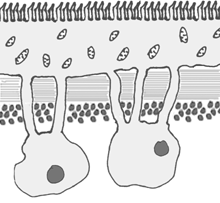Nutrition
Being apart of the platyhelminthes,
Dipylidium caninum and much like
Taenia solium
rely on diffusion for nutrient
acquisition.
The epidermis of Dipylidium caninum is
folded numerous times into finger-like projections to increase
surface area and thus
 nutrient uptake. These folds are commonly
known as microtriches. The surface of Dipylidium caninum
is covered with these as extensions of the tegument that is
the tissue membrane nutrients pass through. This adaptation
makes it possible for platyhelminthes like Dipylidium
caninum to obtain nutrients even in their challenging
environment.
nutrient uptake. These folds are commonly
known as microtriches. The surface of Dipylidium caninum
is covered with these as extensions of the tegument that is
the tissue membrane nutrients pass through. This adaptation
makes it possible for platyhelminthes like Dipylidium
caninum to obtain nutrients even in their challenging
environment.
Platyhelminthes are some of the most surface area specialized organisms in the world, and for good reason. Dipylidium caninum's habitat requires it to have good surface area. As a parasite, Dipylidium caninum feeds on its host. Specifically, the lumen of the small intestines found in dogs, cats, foxes, and sometimes humans.
Back to Home